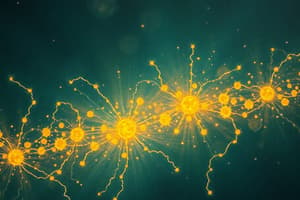Podcast
Questions and Answers
What is the process called when the membrane potential decreases and the cell interior becomes less negative?
What is the process called when the membrane potential decreases and the cell interior becomes less negative?
- Repolarization
- Threshold
- Depolarization (correct)
- Hyperpolarization
During which stage does the membrane become very permeable to sodium ions, allowing them to diffuse into the cell?
During which stage does the membrane become very permeable to sodium ions, allowing them to diffuse into the cell?
- Depolarization Stage (correct)
- Repolarization Stage
- Resting Stage
- Hyperpolarization Stage
What happens during hyperpolarization?
What happens during hyperpolarization?
- Sodium enters the cell, causing depolarization.
- The cell interior becomes less negative.
- Potassium ions flood into the cell.
- The membrane potential becomes more negative than minus 70 mV. (correct)
What is the term for the restoration of the normal resting membrane potential after depolarization?
What is the term for the restoration of the normal resting membrane potential after depolarization?
What initiates the depolarization of a neuron?
What initiates the depolarization of a neuron?
What is the threshold in the context of membrane potentials?
What is the threshold in the context of membrane potentials?
What role does repolarization play in cellular signaling?
What role does repolarization play in cellular signaling?
What characterizes the resting membrane potential of a cell?
What characterizes the resting membrane potential of a cell?
What initiates neurotransmission in a neuron?
What initiates neurotransmission in a neuron?
What type of synaptic transmission involves the receptor protein also serving as an ion channel?
What type of synaptic transmission involves the receptor protein also serving as an ion channel?
Which neurotransmitter is primarily associated with excitatory postsynaptic potentials (EPSP)?
Which neurotransmitter is primarily associated with excitatory postsynaptic potentials (EPSP)?
What type of potential is caused by excitatory synapses leading to membrane depolarization?
What type of potential is caused by excitatory synapses leading to membrane depolarization?
Which of the following ions can be involved in inhibitory postsynaptic potentials (IPSP)?
Which of the following ions can be involved in inhibitory postsynaptic potentials (IPSP)?
What characterizes slow synaptic transmission compared to fast synaptic transmission?
What characterizes slow synaptic transmission compared to fast synaptic transmission?
What is one of the primary factors that influence membrane potential?
What is one of the primary factors that influence membrane potential?
What effect does the Na/K-ATPase pump have on the membrane potential?
What effect does the Na/K-ATPase pump have on the membrane potential?
What effect does opening K+ or Cl- channels generally have on the membrane potential?
What effect does opening K+ or Cl- channels generally have on the membrane potential?
What is the primary function of ligand-gated ion channels?
What is the primary function of ligand-gated ion channels?
What does increasing membrane permeability to Na+ ions do to the membrane potential?
What does increasing membrane permeability to Na+ ions do to the membrane potential?
Which statement about the Nicotinic Acetylcholine Receptors is true?
Which statement about the Nicotinic Acetylcholine Receptors is true?
What type of gating occurs when channels respond to membrane deformation?
What type of gating occurs when channels respond to membrane deformation?
How do changes in membrane potential arise?
How do changes in membrane potential arise?
When is an action potential generated in a neurone?
When is an action potential generated in a neurone?
What is typically the role of the presynaptic neurone in synaptic transmission?
What is typically the role of the presynaptic neurone in synaptic transmission?
Flashcards
Depolarization
Depolarization
The change in membrane potential where the inside of the cell becomes less negative. This happens when positively charged ions like sodium enter the cell.
Hyperpolarization
Hyperpolarization
The change in membrane potential where the inside of the cell becomes more negative. This happens when positively charged ions like potassium leave the cell.
Repolarization
Repolarization
The return of the membrane potential to its resting state after depolarization or hyperpolarization.
Threshold
Threshold
Signup and view all the flashcards
Action Potential
Action Potential
Signup and view all the flashcards
Refractory Period
Refractory Period
Signup and view all the flashcards
Sensory Transduction
Sensory Transduction
Signup and view all the flashcards
Synaptic Transmission
Synaptic Transmission
Signup and view all the flashcards
Neurotransmission
Neurotransmission
Signup and view all the flashcards
Synapse
Synapse
Signup and view all the flashcards
Fast synaptic transmission
Fast synaptic transmission
Signup and view all the flashcards
Excitatory Synapse
Excitatory Synapse
Signup and view all the flashcards
Inhibitory Synapse
Inhibitory Synapse
Signup and view all the flashcards
Slow synaptic transmission
Slow synaptic transmission
Signup and view all the flashcards
Changes in ion concentration's effect
Changes in ion concentration's effect
Signup and view all the flashcards
Electrogenic pumps
Electrogenic pumps
Signup and view all the flashcards
Voltage-Gated Channels
Voltage-Gated Channels
Signup and view all the flashcards
Ligand-Gated Channels
Ligand-Gated Channels
Signup and view all the flashcards
Mechanically Gated Channels
Mechanically Gated Channels
Signup and view all the flashcards
Membrane Ion Permeability
Membrane Ion Permeability
Signup and view all the flashcards
Changing Membrane Ion Permeability
Changing Membrane Ion Permeability
Signup and view all the flashcards
Presynaptic Neuron
Presynaptic Neuron
Signup and view all the flashcards
Postsynaptic Neuron
Postsynaptic Neuron
Signup and view all the flashcards
Study Notes
Membranes and Receptors - Session 3
- Lecture 3.2: Changing Membrane Potentials
- Changes in membrane potential are fundamental to cell signaling, both between cells and within a single cell.
- Examples:
- Action potentials in nerve and muscle cells
- Triggering and controlling muscle contractions
- Regulating hormone and neurotransmitter secretion
- Transduction of sensory information into electrical signals
- Postsynaptic actions in fast synaptic transmission
Depolarization
- A decrease in membrane potential from its normal value.
- The cell interior becomes less negative.
- Example: A change from −70 mV to −50 mV.
- Occurs when sodium ions enter the cell.
Hyperpolarization
- An increase in the size of the membrane potential from its normal value.
- The cell interior becomes more negative.
- Example: A change from −70 mV to −90 mV.
- Occurs when potassium ions leave the cell.
Repolarization
- The return to the resting membrane potential after depolarization or hyperpolarization.
- Moves back towards −70 mV.
Threshold
- The membrane potential value that triggers the opening of voltage-gated sodium channels.
- This is the point where the first voltage-regulated sodium channel opens.
Positive Charge for Depolarization
- To depolarize a cell, a positive charge must be introduced into the cell.
Depolarization Stage
- Membrane permeability to sodium ions suddenly increases.
- Large numbers of positively charged sodium ions enter the axon.
- The normal polarized state (−90 mV) is neutralized, and the potential rapidly rises in the positive direction—this is depolarization.
Repolarization Stage
- Within milliseconds of depolarization, sodium channels close.
- Potassium channels open more than usual.
- Rapid potassium ion diffusion out of the axon re-establishes the normal negative resting membrane potential—this is repolarization.
Voltage-Gated Sodium Channels
- Channels that open and close at specific membrane potentials.
- These channels are crucial for action potentials.
- Different stages:
- Inactivated or delayed (+35 to -90 mV)
- Resting (-90 mV)
- Activated (-90 to +35 mV)
Voltage-Gated Potassium Channels
- Channels that respond to changes in membrane potential.
- They play a role in repolarization and return to the resting state.
- Stages:
- Resting (-90mV)
- Slow activation (+35 to -90mV)
Action Potential Graph
- Describes voltage changes over time.
- Shows the phases of depolarization, repolarization, and refractory period.
Changing Membrane Ion Permeability
- Membrane permeability changes influence membrane potential changes.
- The potential moves towards the equilibrium potential for the ion.
- Equilibrium potentials for key ions:
- K⁺: −95 mV
- Na⁺: +70 mV
- Ca²⁺: +122 mV
- Cl⁻: −96 mV
Less Selective Channels (Example: Nicotinic Acetylcholine Receptors)
- Channels that aren't exclusively selective to one type of ion.
- The nicotinic acetylcholine receptors allow both Na⁺ and K⁺ ion passage but block anions.
- Situated at the neuromuscular junction.
Controlling Channel Activity
- Channels can open or close, and this is termed gating.
- Types of Gating:
- Ligand Gating: Channels open or close in response to chemical ligands, e.g., neurotransmitters at synapses.
- Voltage Gating: Channels respond to changes in membrane potential; crucial for action potentials.
- Mechanical Gating: Channels respond to membrane deformation, e.g., mechanoreceptors.
Synaptic Transmission
- Action potentials travel across synapses via neurotransmission.
- Neurotransmission begins with the presynaptic neuron releasing a neurotransmitter.
- Neurotransmitters travel across the synaptic cleft and bind to receptors on the postsynaptic membrane.
- The postsynaptic neuron responds appropriately, and the neurotransmitter is removed or deactivated.
Generic Neurotransmitter System
- Illustrates the process of neurotransmitter release, binding, and subsequent degradation/removal.
Synaptic Connections
- Synapses occur between nerve cells, nerve-muscle cells, and nerve-gland cells.
- At each synapse, a chemical transmitter from the presynaptic cell interacts with receptors on the postsynaptic membrane.
Fast Synaptic Transmission
- Receptor proteins are ion channels.
- Transmitter binding directly opens the channel.
Excitatory Synapses
- Excitatory transmitters open ligand-gated channels that increase membrane permeability to Na⁺ and Ca²⁺.
- Membrane depolarization results, creating an EPSP (excitatory postsynaptic potential).
- Examples include glutamate and acetylcholine.
Inhibitory Synapses
- Inhibitory transmitters open ligand-gated channels that increase membrane permeability to K⁺ or Cl⁻.
- Membrane hyperpolarization occurs, creating an IPSP (inhibitory postsynaptic potential).
- Examples include GABA and glycine.
Postsynaptic Potentials (ERP and IPSP)
- Postsynaptic potentials resulting from excitation and inhibition.
Slow Synaptic Transmission
- Receptor proteins and ion channels are distinct.
- Two basic mechanisms:
- Direct G-protein gating
- Gating via an intracellular messenger (e.g., receptor-G-protein channels).
Two Other Factors Influencing Membrane Potential
- Ion Concentration Changes: Extracellular potassium concentration is especially significant, affecting membrane excitability; alterations can occur clinically (e.g., hyperkalemia).
- Electrogenic Pumps: Na+/K+-ATPase pumps contribute to membrane potential by moving ions across the membrane; some drugs affect this pump.
Studying That Suits You
Use AI to generate personalized quizzes and flashcards to suit your learning preferences.


